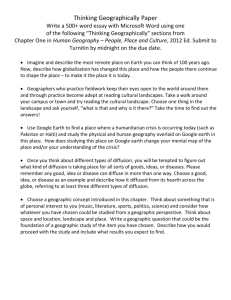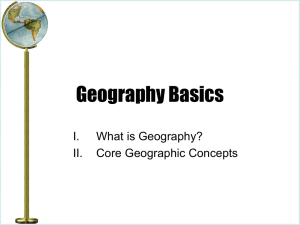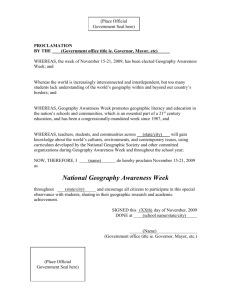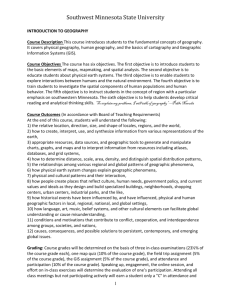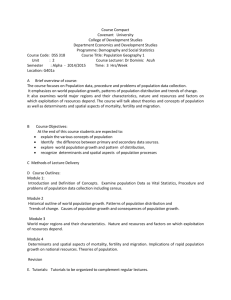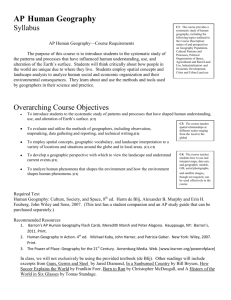AP Microeconomics - NHV Regional HS District
advertisement
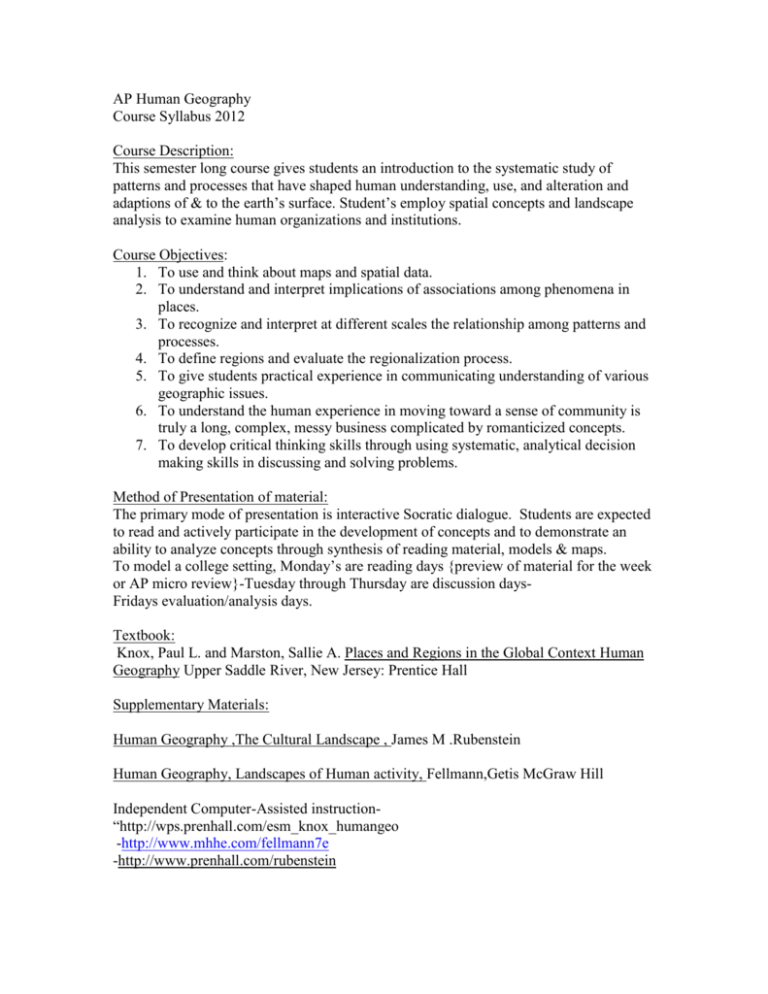
AP Human Geography
Course Syllabus 2012
Course Description:
This semester long course gives students an introduction to the systematic study of
patterns and processes that have shaped human understanding, use, and alteration and
adaptions of & to the earth’s surface. Student’s employ spatial concepts and landscape
analysis to examine human organizations and institutions.
Course Objectives:
1. To use and think about maps and spatial data.
2. To understand and interpret implications of associations among phenomena in
places.
3. To recognize and interpret at different scales the relationship among patterns and
processes.
4. To define regions and evaluate the regionalization process.
5. To give students practical experience in communicating understanding of various
geographic issues.
6. To understand the human experience in moving toward a sense of community is
truly a long, complex, messy business complicated by romanticized concepts.
7. To develop critical thinking skills through using systematic, analytical decision
making skills in discussing and solving problems.
Method of Presentation of material:
The primary mode of presentation is interactive Socratic dialogue. Students are expected
to read and actively participate in the development of concepts and to demonstrate an
ability to analyze concepts through synthesis of reading material, models & maps.
To model a college setting, Monday’s are reading days {preview of material for the week
or AP micro review}-Tuesday through Thursday are discussion daysFridays evaluation/analysis days.
Textbook:
Knox, Paul L. and Marston, Sallie A. Places and Regions in the Global Context Human
Geography Upper Saddle River, New Jersey: Prentice Hall
Supplementary Materials:
Human Geography ,The Cultural Landscape , James M .Rubenstein
Human Geography, Landscapes of Human activity, Fellmann,Getis McGraw Hill
Independent Computer-Assisted instruction“http://wps.prenhall.com/esm_knox_humangeo
-http://www.mhhe.com/fellmann7e
-http://www.prenhall.com/rubenstein
E-mail subscription. Ethics, Place and Environments.
Supplemental readings sources: National Geographic, Journel of Geography
The Geographical Review, Geography World
Evaluations:
Weekly subjective Quiz: GIVEN AT ANY TIME
Free response questions-examination & synthesis of patterns & physical features
Map & Model analysis & interpretations and drawing.
Oral Presentations-developed and developing worlds
Group problem solving-investigation of spatial analysis
Computer assisted field trips-virtual geographies
Field assignments-comparisons local to global continuum
Paper due Every 2 weeks {Feb.10 & 24, March 9 & 23,April 5} Student will
develop the question based on 2 weeks of study and completed in the A B C D style
found in the AP acorn book-1 page typed/single space
9 week Exam - Subjective [essay] Exam
Final Exam -Objective questions [multiple choice] & Subjective [essay] Exam
Course Topical Outline:
Week 1 & 2{Jan. 30-Feb.10}-Geography: Its Nature & Perspectives
Uniqueness of Place
Interdependence in a Globalizing World
Geographic Information System
Fundamental geographic observations & basic concepts
Regional concepts
Concepts of Spatial Analysis
Means of visualizing & analyzing spatial data
Geographic Expansion, Integration and change
Industrialization and geographic change
Internal development of the core regions
Organizing the periphery
Types of Maps
The fast world and the slow world
World leadership cycles
Global outlook/local prospects
Changing face of the landscape
Role of Human Geography
Analyzing Models
Thinking about Space, Place, Region, Scale
Making Geographic connections/thinking Geographically
Week 3{Feb.13-17}-Geographies of Population
Major influences on population distribution
Spatial interaction
Spatial behavior
Migration patterns-why do people migrate, migration distribution
Migration within a country/region
Population models
Data & measurement
Demographic transition
Population distributions
Population projections
Population structure
Population dynamics
Population movement
Population diffusion
Population polices
The baby boom and its impact
Where is the World’s population distributed, where has it increased, why is
population increasing at different rates in different places
Over population?
Week 4{Feb.21 -24}- Cultural Patterns & Processes
Nature as a concept
Nature of human-environmental relations
Historical transformation of the surface
Global climatic change
Human expansion and action
Structure of culture & cultural change
Environmental change
Culture as a geographic process
Cultural complexes and systems
Cultural nationalism
Culture and the physical environment
Globalization and change
Classification-families-origins/spread & distribution of language
Language as cultural identity-preservation of local languages/distribution
Landscape relic
Role of religion/religious conflict
Religion distribution/organized space & distinctive patterns
Towards a global culture?
Landscape as a text
Place Marketing
Semiotics in the landscape
Economic development of Space
Postmodern spaces
Cultural geography of cyberspace
Cultural dissonance
Ethnic diversity/conflict
Ethnicities-nationalities
Folk culture/Popular culture diffusion
Folk clusters/housing types
Patterns of Popular culture/Globalization
Human impacts on Environment
Week 5{Feb.27-March 2} -The Politics of Territory and Space
Geopolitical model of the state
Location of states/Changing borders
Shape of states
Boundaries & problems
National political units & cooperation
Nationalism/nationalities
Representation & fragmentation
Frontier regions
Boundary formation & concerns
Theories and practices of the state
Politics of geography
Regionalism/sectionalism
International political systems
Law of the Sea
State case studies
Adjusting to the future/scale & territory
Economic cooperation
Week 6{March 5-9}-Agriculture, Food Production & Rural Land Use
Traditional agricultural geography/origins of Ag
Agricultural Revolution
Agricultural Industrialization
Agricultural regions
Distribution of Ag. in Developed nations
Global agricultural systems
Social and technological agricultural change
Impact of environment on agriculture
Impact of agriculture on environment
Subsistence Agriculture
Commercial Agriculture
Non-Farming primary activities
Environmental/Cultural factors
Economic issues
Future of Ag
Week 7 & Week 8{March 12-23}-Geography of Economic Development
Unevenness of economic development
Distribution of development
Distribution of industrial development
Industrial Issues
Role of services/service clusters
Central place theory
Market place analysis
Obstacles to development
Resources and technology
Principles of commercial and industrial development
Economic and agglomeration effects
Regional economic cores
Modification of core –periphery patterns
Global assembly line
Global office
Political and cultural modifications of economic development
Economic development of Space
Spatial change/technology
Productive activities
Economic Classifications
Trade/national & international
Manufacturing locations
Comparative advantage
World patterns & economic regions
Recent developments & impacts of world economic patterns
Economic models of development
Week 9 & Week 10 {March 26-April 5} -City Spaces & Urban Land Structures
Nature of cities
Defining urban settlements
3 Models of urban structures/use of models outside North America
Peripheral model
Distribution of people within urban areas
Economic base of cities
Patterns of urban change
Developing world & urban diversity
Urban expansion
World urban trends
Industrialization/urbanization
Regional urban trends
Projected urbanization
Urban systems/transportation systems
Urbanization & economic development
Deindustrialization/decentralization
Counter urbanization/suburbanization
Unintended Metropolis
Territoriality/congregation & segregation
Functional clustering
Social ecology
Comparative urban structures
Symbolic landscapes
Planned urban design
Fiscal problems
Infrastructure problems
Environmental degradation
Contrasts in the city
Week 11{April 16-20}
Reading-Future Geographies
Pollution
Resources
Global Themes
Analyze the local to global continuum
Evaluate the concept of global geographic change
Experience virtual geography[ or field experience]
Week 12 {April 23-27}
FINAL EXAM WEEK- Free response questions
2 days of subjective testing
Week 13 {April 30-May 4}
Review for AP Exams
Week 14 {after AP Exams} {May 21-24}
Prepare for final exam question
Week 15{May 30-June 1}
Planning board simulation
NH school District
Raise the prospects of mapping future geography
Committees established
Panel reports given and future maps presented

